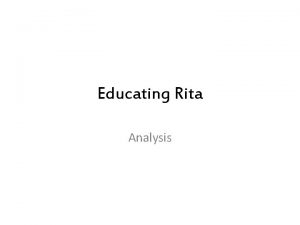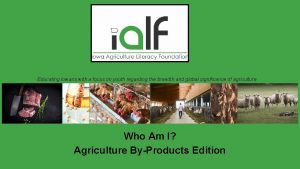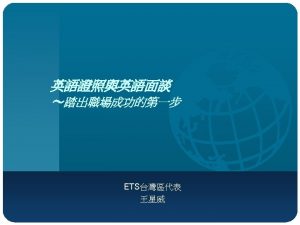Educating Iowans with a focus on youth regarding









- Slides: 9

Educating Iowans with a focus on youth regarding the breadth and global significance of agriculture. Managing the Threat and Protecting the Harvest – Soybean Aphids

Agroecosystems – Pests HS-LS 2 -2. Use mathematical representations to support and revise explanations based on evidence about factors affecting biodiversity and populations in ecosystems of different scales. Aphid count on soybeans to determine if/when to spray. Maintaining a balance in the ecosystem by increasing the number of ladybugs to control the aphids. • Problem since 2000 -2004 when aphids were introduced

Agroecosystems – Pests Aerial picture of unsprayed (left) vs. sprayed (right) field areas demonstrates the dramatic effect of soybean aphids and the benefit of treating.

Agroecosystems – Pests Soybean aphid: a) typical colony-building wingless (apterous) form. Photo credit to Claudio Gratton; and b) migratory winged (alatae) form. Photo credit to Marlin E. Rice.

Agroecosystems – Pests

Agroecosystems – Pests

Agroecosystems – Pests Speed Scouting Directions 1. Select the first plant at random. If less than 40 aphids are on the entire plant, mark a minus [-] for that non-infested plant. If at least 40 aphids are on the plant (STOP COUNTING when you reach 40 – this is the speedy part), mark a plus [+] for that infested plant. 2. Choose a direction at random and walk 30 rows or paces to the next plant. 3. Repeat Step #1 until 11 plants are sampled in different areas of the field. 4. Make a decision using the total number of infested plants (the total number of pluses). 5. If you must ‘continue sampling’ (7 to 10 plants with a +), sample five more plants and use the new total number of plants (16) to make a decision. 6. If no decision is reached, sample additional sets of five plants until 31 plants are sampled. Remember, always use the total number of plants to make a decision. 7. If no decision can be made after sampling 31 plants, resample the same field in 3 to 4 days. 8. A ‘TREAT’ decision must be confirmed a second time 3 to 4 days later. If confirmed, apply an insecticide in 3 to 4 days.

Agroecosystems – Pests

Agroecosystems – Pests Common soybean aphid natural enemies • a) multicolor Asian lady beetle, Harmonia axyridis, larva. Photo credit to Whitney Cranshaw; • b) multicolored Asian lady beetle adult. Photo credit to Marlin E. Rice; • c) green lacewing, Chrysoperla spp. , larva. Photo credit to Jack Dykinga; • d) insidious flower bug, Orius insidiosus, nymph. Photo credit to Marlin E. Rice; • e) spined soldier bug, Podisus maculiventris, nymph. Photo credit to Russ Ottens; • f) parasitoid wasp, Lysiphlebus testaceipes. Photo credit to Peter J. Bryant.
 Educating the mind without educating the heart source
Educating the mind without educating the heart source Actor focus vs object focus
Actor focus vs object focus Prolepsis
Prolepsis Integrated cost leadership/differentiation strategy
Integrated cost leadership/differentiation strategy Cost leadership strategy
Cost leadership strategy Educating the next generation of leaders
Educating the next generation of leaders Promote service arrange decide
Promote service arrange decide Educating for eternity
Educating for eternity Educating rita analysis
Educating rita analysis Promoting services and educating customers
Promoting services and educating customers
















